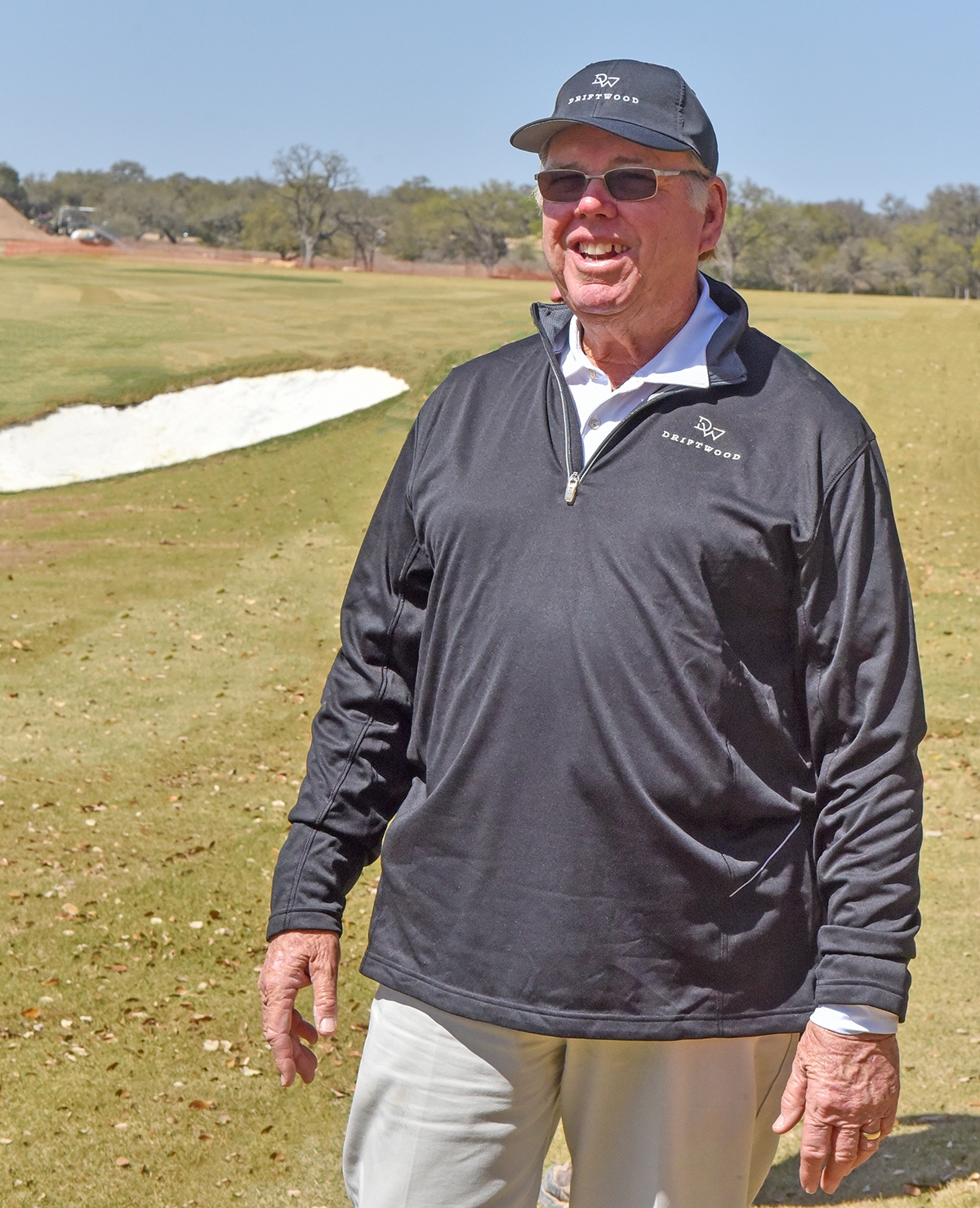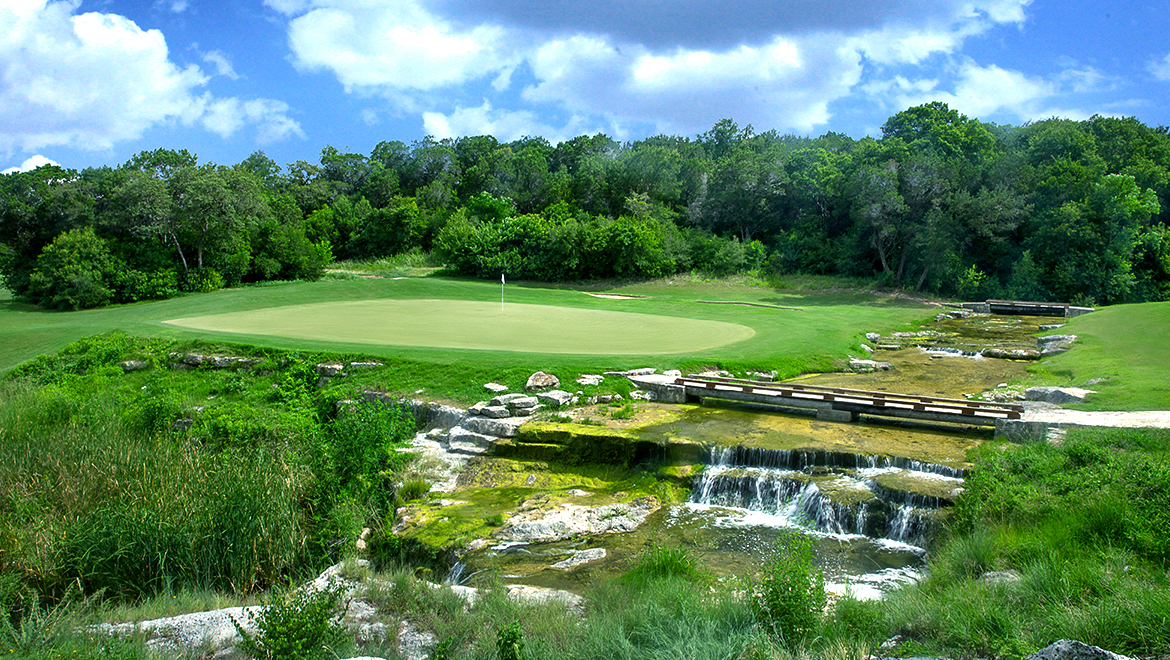Tom Fazio OTL Question and Answer
 One of the more popular bumper stickers in these parts reads, ‘I wasn’t born in Texas, but I got here as soon as I could.’
One of the more popular bumper stickers in these parts reads, ‘I wasn’t born in Texas, but I got here as soon as I could.’
Tom Fazio, 76, certainly wasn’t born here, growing up in the Philadelphia suburbs and going to work for his uncle, 10-PGA Tour winner George, in the 1960s in the family golf architecture business.
He does not live in Texas (North Carolina in the summer and fall, Florida in the winter and spring), but has been here enough times to design highly rated courses, he could almost be considered an honorary Texan.
Fazio first arrived in Texas in the mid-1980s to build the first Barton Creek Golf Course in West Austin for Texas political legends John Connally and Ben Barnes. That’s where he first met Brent Buckman, then a recent graduate from the University of Texas, now the Director of Golf at the new Driftwood Golf Course, just south of Austin, and first became aware of the possibility of Texas golf.
The original Barton Creek Course along with Wayne and Norman’s Hurd Horseshoe Bay project jump-started the Hill Country golf boom which is still ongoing. Not only did Fazio do two courses at Barton Creek, but he also did the outstanding Escondido course at Horseshoe Bay and has recently been working on Driftwood in the small town of the same name which will open this fall.
No non-Texas architect has done more original Lone Star courses than Fazio and very few architects of any kind have done as many courses in as many different Texas locations.
Fazio has worked from El Paso (Butterfield National) to Dallas (Vaquero, Westin Stonebriar and Dallas National), The Woodlands (Carlton Woods) to San Antonio (Briggs Ranch), and Horseshoe Bay (Escondido Golf & Lake Club) to Austin (Barton Creek Foothills and Canyons) and now Driftwood.
That doesn’t even count the re-dos, renovations and recommendations to various Lone Star Links landowners.
Still, he’s as energetic as ever to build the next great golf course, likely in Texas, or somewhere else where he has his name on some of the great courses and renovations around the country and in the UK.
With his sons Logan and Austin, he is still active in the business having designed more than 200 courses nationwide with 46 of them being named to the greatest 200 courses in America by Golf Digest.
Recently he said his wife has just taken up golf and wanted to play every course her husband had designed. “I’m not sure I can remember them all,” he replied with a smile.
But he was happy to talk recently with OTL Senior Writer Art Stricklin about his golf courses in Texas and elsewhere, what he loves about working in the Lone Star State and “Bryson Proofing” Augusta National.
Enjoy the conversation with America’s great living architect.
OTL: You have done so many great golf courses in your career, is there a certain Tom Fazio style?
TOM FAZIO: My philosophy is that my work has no style. It all depends on the course. Vaquero (Westlake) had a different style than Dallas National which has a different style than Briggs Ranch (San Antonio). All different kinds of styles and no overriding style at all. I guess the only thing you can say is I don’t like to do the same golf course design over and over again. To me, that’s boring. I want to do something different.
OTL: One of the things your courses are known for is hiding the cart paths. How do you go about making sure the concrete doesn’t get in the way of the course.
TF: To me, cart paths are just a hard surface. It’s part of the game of golf now, but you can’t let it destroy the elements of nature. As a traditionalist, I’d like to do away with all cart paths, but that’s not reality now. Cart paths are about creating access for some people. Cart paths are a necessary evil now and you have to be able to work around them.
 OTL: It’s pretty amazing when you look at all the courses all over the state of Texas. There is hardly a major area you haven’t work in. What have you learned from working so much in Texas?
OTL: It’s pretty amazing when you look at all the courses all over the state of Texas. There is hardly a major area you haven’t work in. What have you learned from working so much in Texas?
TF: There are just two things I learned from designing so many Texas courses. One, you’re going to hit rock if you go more than two to three feet below the surface. I go to work on a new Texas course and you hit rock and, yep, there it is again.
Secondly, you also know the wind is going to blow a good portion of the time, so you always have to take that into account. I always want to take a good piece of land and make it great, but in the Hill Country, it’s hard to find a bad piece of land. In Austin, I don’t think you can do it.”
OTL: When you talk about the rock at many of the Lone Star courses you design, how do you defeat that?
TF: Well, you need a whole lot of dynamite and an unlimited budget, which usually helps.
OTL: Are you surprised you’ve done as many courses as you have in Texas, considering you don’t live here and you travel all over the country to design courses?
TF: 35 years ago when I first opened Barton Creek, I never knew I would return to Texas so many times to design courses, but I hoped I would.
OTL: Why do you think that is?
TF: Texas is full of “can do” people who want courses done right. John Connally and Ben Barnes were can do political figures, Jim Bob Moffitt (instrumental in the development of the second Barton Creek course), was can do, Mike Meldman (developer of Vaquero and Driftwood) is another one. That helps when you want to do any great courses. You’ve got to have a great partner. OTL: You’ve been designing golf courses for four decades, is golf course design harder or easier now?
TF: I think everything is easier now and anybody who says the good old days were the best doesn’t remember it the way it was. We are able to build on more difficult sites now because of the technology and the modern equipment we have now.
Look at the new Driftwood course we’re doing just south of Austin. It will have the best of modern technology and new-age grasses, zeon zoysia grass on the fairways and tees, 007 bentgrass on the greens, it will have sand capping to help drainage from Central Texas rains and lined manmade lakes to prevent seepage during droughts and downpours
OTL: You’ve won a ton of awards and honors in your career, but is there pressure to always try to top yourself with another new course in Texas or elsewhere?
TF: If I stop designing courses today, I could live on my laurels for a while, but I’m always being judged by my newest course and that’s the way I like it.
At Barton Creek, the (first) Canyons was good and well accepted, but when I did the second one the pressure was on and it had to be good or people would say, “Oh my gosh, he’s slipping.”
It keeps you working and keeps me out of the bars, because the challenge is, the industry is very competitive. It’s like Tiger Woods in his prime. If he missed two cuts one year, did he have a bad year? He won two majors and finished second and fourth in the others, did he have a bad year with the two missed cuts? You’re always judged by your latest efforts. People hire me for quality and because we have a commitment to quality, but the only thing that counts is the end results.
OTL: One of the places you have worked was Augusta National. There was always talk about Tiger proofing the courses when he was winning Masters, do you think we need to Bryson proof the Masters course now?
TF: We’ll just have to wait and see about that. The holes at the Masters if you try to cut over them like he wants to do, you just go further away from the fairways. It’s not a straight shot to carry over the trees. Bryson has played in the Masters I think three times. We haven’t had to change anything yet. So we will just have to wait and see. Working at Augusta national has been a great honor and privilege and a great relationship with those people.
OTL: Are there any new trends for the 21st century?
TF: I don’t really know of any, but I’ve never been a big trend person. The trend of the 1980s was to build hard and difficult courses, but I’ve never done that. Golf is an old and traditional game and that’s the way I like to build. Shadow Creek (Las Vegas) foreshadowed a trend of building a course in a desert location like building the Westin Stonebriar (Frisco) in an overgrown wheat field.
OTL: When people want a Tom Fazio golf course, are they aware of the cost involved?
TF: They know that Fazio is not the cheapest architect out there, he’s one of the most expensive actually. A lot of times I try to talk people out of doing a project because they need to make sure it makes financial sense. I tried to talk the people out of doing Dallas National, to make sure it made sense, but they had a dream and were going to set the market and that’s what they did.
OTL: Have prices increased for great golf courses as they have for everything else in the golf industry?
TF: When I first started in the 1960s, you could build an entire course for $180,000 to $200,000, total, that was everything. Now you spend that much on landscaping or marketing or advertising.
OTL: Thanks for the time and the interesting conversation.
TF: You’re welcome.
By Art Stricklin